ABSSeq: a new RNA-Seq analysis method based on modelling absolute expression differences
- PMID: 27488180
- PMCID: PMC4973090
- DOI: 10.1186/s12864-016-2848-2
ABSSeq: a new RNA-Seq analysis method based on modelling absolute expression differences
Abstract
Background: The recent advances in next generation sequencing technology have made the sequencing of RNA (i.e., RNA-Seq) an extemely popular approach for gene expression analysis. Identification of significant differential expression represents a crucial initial step in these analyses, on which most subsequent inferences of biological functions are built. Yet, for identification of these subsequently analysed genes, most studies use an additional minimal threshold of differential expression that is not captured by the applied statistical procedures.
Results: Here we introduce a new analysis approach, ABSSeq, which uses a negative binomal distribution to model absolute expression differences between conditions, taking into account variations across genes and samples as well as magnitude of differences. In comparison to alternative methods, ABSSeq shows higher performance on controling type I error rate and at least a similar ability to correctly identify differentially expressed genes.
Conclusions: ABSSeq specifically considers the overall magnitude of expression differences, which enhances the power in detecting truly differentially expressed genes by reducing false positives at both very low and high expression level. In addition, ABSSeq offers to calculate shrinkage of fold change to facilitate gene ranking and effective outlier detection.
Keywords: ABSSeq; Differential gene expression; Negative binomial distribution; RNA-Seq; Transcriptome analysis.
Figures
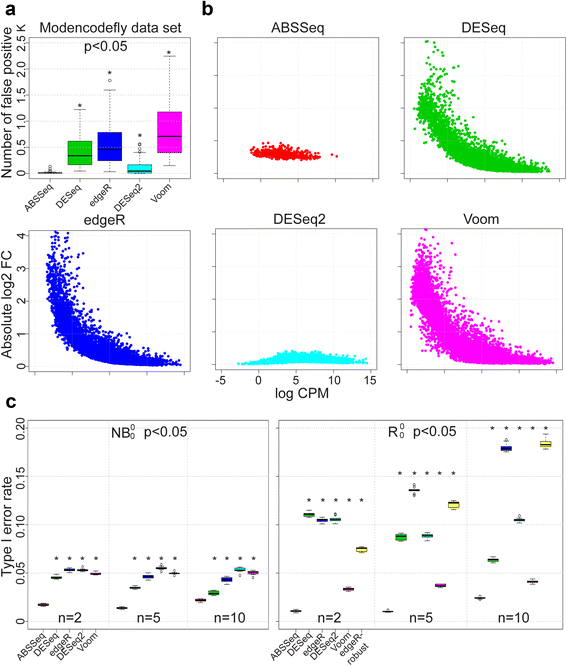
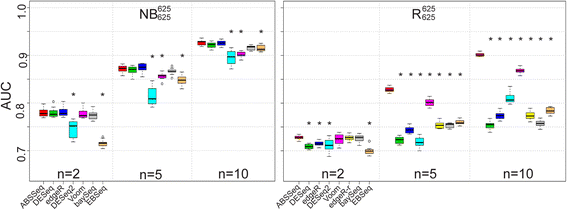
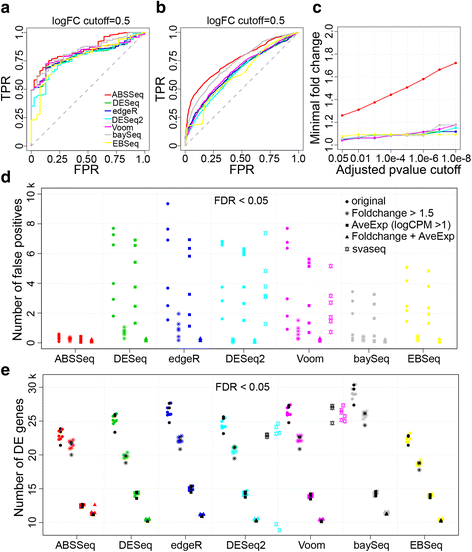
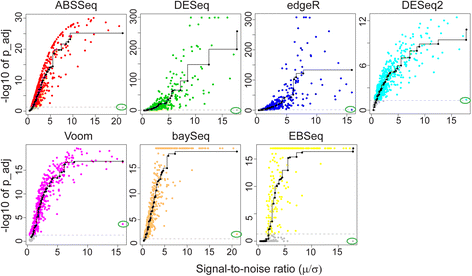
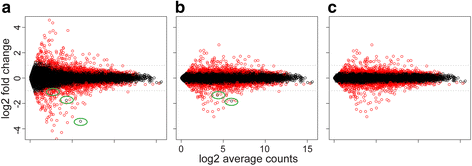
Similar articles
-
aFold - using polynomial uncertainty modelling for differential gene expression estimation from RNA sequencing data.BMC Genomics. 2019 May 10;20(1):364. doi: 10.1186/s12864-019-5686-1. BMC Genomics. 2019. PMID: 31077153 Free PMC article.
-
Differential correlation for sequencing data.BMC Res Notes. 2017 Jan 19;10(1):54. doi: 10.1186/s13104-016-2331-9. BMC Res Notes. 2017. PMID: 28103954 Free PMC article.
-
Identifying differentially spliced genes from two groups of RNA-seq samples.Gene. 2013 Apr 10;518(1):164-70. doi: 10.1016/j.gene.2012.11.045. Epub 2012 Dec 8. Gene. 2013. PMID: 23228854
-
A comparison of statistical methods for detecting differentially expressed genes from RNA-seq data.Am J Bot. 2012 Feb;99(2):248-56. doi: 10.3732/ajb.1100340. Epub 2012 Jan 20. Am J Bot. 2012. PMID: 22268221 Review.
-
Statistical detection of differentially expressed genes based on RNA-seq: from biological to phylogenetic replicates.Brief Bioinform. 2016 Mar;17(2):243-8. doi: 10.1093/bib/bbv035. Epub 2015 Jun 24. Brief Bioinform. 2016. PMID: 26108230 Review.
Cited by
-
The C. elegans GATA transcription factor elt-2 mediates distinct transcriptional responses and opposite infection outcomes towards different Bacillus thuringiensis strains.PLoS Pathog. 2020 Sep 24;16(9):e1008826. doi: 10.1371/journal.ppat.1008826. eCollection 2020 Sep. PLoS Pathog. 2020. PMID: 32970778 Free PMC article.
-
Fibromine is a multi-omics database and mining tool for target discovery in pulmonary fibrosis.Sci Rep. 2021 Nov 5;11(1):21712. doi: 10.1038/s41598-021-01069-w. Sci Rep. 2021. PMID: 34741074 Free PMC article.
-
HKDC1 promotes liver cancer stemness under hypoxia through stabilizing β-catenin.Hepatology. 2025 Jun 1;81(6):1685-1699. doi: 10.1097/HEP.0000000000001085. Epub 2024 Sep 6. Hepatology. 2025. PMID: 39250463 Free PMC article.
-
mitch: multi-contrast pathway enrichment for multi-omics and single-cell profiling data.BMC Genomics. 2020 Jun 29;21(1):447. doi: 10.1186/s12864-020-06856-9. BMC Genomics. 2020. PMID: 32600408 Free PMC article.
-
Massively parallel variant characterization identifies NUDT15 alleles associated with thiopurine toxicity.Proc Natl Acad Sci U S A. 2020 Mar 10;117(10):5394-5401. doi: 10.1073/pnas.1915680117. Epub 2020 Feb 24. Proc Natl Acad Sci U S A. 2020. PMID: 32094176 Free PMC article.
References
Publication types
MeSH terms
LinkOut - more resources
Full Text Sources
Other Literature Sources
Molecular Biology Databases

